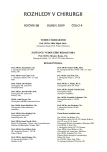Antimicrobial Treatment in Complicated Intraabdominal Infections – Current Situation
Authors:
F. Vyhnánek
Authors‘ workplace:
Chirurgická klinika 3. LF UK, Praha
Published in:
Rozhl. Chir., 2009, roč. 88, č. 4, s. 206-213.
Category:
Monothematic special - Original
Overview
Compared to other infections, intraabdominal infections include wide spectrum of infections of various severity, have different ethiology, which is frequently polymicrobial, show different microbiological results, which are difficult to interpret. The role of surgical intervention is essential. Intraabdominal infections are common causes of morbidity and mortality. Their prognosis is significantly improved with early and exact diagnosis, appropriate surgical or radiological intervention and timely effective antimicrobial therapy. Practitioners may choose between older or more modern antibiotics, between monotherapy or combination therapy, however, they should also consider clinical condition of the patient, the antibiotic’s spectrum of activity, the treatment timing and its duration, the dose and dosing scheme of the particular antimicrobials. Furthermore, antimicrobial therapy should be used with caution, with the aim to prevent development of antimicrobial resistence. Inappropriate choice of antimicrobials in initial empiric therapy results in relapsing infections, surgical intervention and prolongation of hospitalization, and even death rates reflect adequate and timely empiric therapy.
Key words:
intraabdominal infections – antimicrobial treatment – empiric and targeted therapy
Sources
1. Blot, S., De Waele, J. J. Critical issues in the clinical management of complicated intra-abdominal infections. Drugs, 2006: 65: 1611–1620.
2. Ordonez, C. A., Puyana, J. C. Management of peritonitis in the criticaly ill patiens. Surg. Clin. N. Am., 2006: 86: 1323–1349.
3. Pieracci, F. M., Barie, P. S. Management of severe sepsis of abdominal origin. Scand. J. Surg., 2007: 96: 184–196.
4. Marshall, J. C. Intra-abdominal infections. Microbes and Infection, 2004: 6: 1015–1025.
5. Monteiro, M. C., Danielou, A., Piemont, Y., Hansmann, Y., Rohr, S. Bacterial cultures and empirical antimicrobial therapy for community-acquired secondary peritonitis. J. Chir., 2007: 144: 486–491.
6. Lochmann, O. Základy antimikrobní terapie. Triton, Praha, 1994: 175.
7. Malangoni, M. A. Contributions to the management of intraabdominal infections. Am. J. Surg, .2005: 190: 255–259.
8. Sihler, K. C., Nathens, A. B. Management of severe sepsis in the surgical patient. Surg. Clin. N. Am., 2006: 86: 1457–1481.
9. Sganga, G. Antibiotic treatment of intra-abdominal and post-surgical infections. Ifez Med., 2005: Suppl: 18–24.
10. Chan, Y. J., Chang, F. Y., Chang, S. Ch., et al. Guidelines for antimicrobial therapy of intra-abdominal infections in adults. J. Microbiol. Immunol. Infect., 2008: 41: 279–281.
11. Kujath, P., Hoffmann, M., Rodloff, A. Antimicrobial and antimycotic therapy of intra-abdominal infections. Chirurg, 2008: 79: 295–305.
12. Nicoletti, G., Nicolosi, D., Rossolini, G.M., Stefani, S. Etiology, epidemiology and microbiological diagnosis of intra-abdominal infections. Infez. Med., 2008: 16: Suppl. 1: 8–18.
13. Koblihová, H., Suchopár, J. Kabapenemy: přehled a porovnání základních údajů. Remedia, 2008: 18: 247–251.
14. Gin, A., Dilay, L., Karlowsky, J., et al. Piperacillin-tazobactam: a beta-lactam/ beta-lactamase inhibitor combination. Expert Rev. Anti Infect. Ther., 2007: 5: 365–383.
15. Marešová, V., Urbášková, P. Tigecyklin. Remedia, 2008: 18: 194–200.
16. Eagye, K .J., Kuti, J. L., Dowzicky, M., Nicolau, D. P. Empiric therapy for secondary peritonitis: a pharmacodynamic analysis of cefepime, ceftazidime, cetriaxone, imipenem, levofloxacin, piperacillin/ tazobactam, and tigecycline using Monte Carlo simulation. Clin. Ther., 2007: 29: 889–899.
17. Navarro, N. S. Jr., Campos, M. I., Alvarado, R., et al. Ertapenem versus ceftriaxone nad metronidazole as treatment for complicated inta-abdominal infections. Int. J. Surg., 2005: 3: 25–34.
18. Falagas, M. E., Peppas, G., Makris, G. C., et al. Meta-analysis: ertapenem for complicated intra-abdominal infections. Aliment Pharmacol. Ther., 2008: 27: 919–931.
19. Tellado, J. M., Wilson, S. E. Empiric treatment of nosocomial intra-abdominal infections: a focus on the carbapenems. Surg. Infect., 2005: 6: 329–343.
20. Menichetti, F. New options for treatment of intraabdominal infections: tigecycline. Infez. Med., 2008: 16: Suppl. 1: 53–56.
21. Doan, T. L., Fung, H. B., Mehta, D., Riska, P. F. Tygecycline : a glycylcycline antimicrobial agent. Clin. Ther., 2006: 28: 1079–1106.
22. Shakil, S., Akram, M., Khan, A. U. Tygecycline: a critical update. J. Chemother., 2008: 20: 411–419.
23. Krov, G., K@oleian, E. Microbiology and treatment of the abdominal gunshot injury. Khirurgiia, 2006: 3: 47–54.
24. Cerullo, G., Marrelli, D., Roviello, F., et al. Empiric antibiotic therapy in the treatment of postoperative abdominal abscesses. Clinical and microbiological data. Chir. Ital., 2006: 58: 477–484.
25. Hart, P. A., Bechtold, M. L., Marshall, J. B., et al. Prophylactic antibiotics in necrotizing pancreatitis: a meta-analysis. South. Med. J., 2008: 101: 1126–1131.
26. Dellinger, E. P., Tellado, J. M., Soto, N. E., et al. Early antibotic treatment for severe acute necrotizing pankreatitis: a randomized, double-blind, placebo-controlled study (feature). Ann. Surg., 2007: 245: 674–683.
27. Xu, T., Cai, Q. Prophylactic antibiotic treatment in acute necrotizing pancreatitis: results from a meta-analysis. Scand. J. Gastroenterol., 2008: 43: 1249–1258.
28. Sood, S., Malhotra, M., Das, B. K., Kapil, A. Enterococcal infections – antimicrobial resistance. Indian J. Med. Res., 2008: 128: 111–121.
29. Boos, C., Kujath, P., Bruch, H. P. Intra-abdominal mycoses. Mycoses, 2005: 48: Suppl. 1: 22–26.
30. Macgowan, A. P. Clinical implications of antimicrobial resistence for therapy. J. Antimicrob. Chemother., 2008: 62: Suppl. 2: 105–114.
Labels
Surgery Orthopaedics Trauma surgeryArticle was published in
Perspectives in Surgery

2009 Issue 4
Most read in this issue
- Truncus Coeliacus Stenosis in Duodenopancreatectomy
- Neoplastic Thrombosis of the Inferior Vena Cava in Kidney Carcinoma
- Antimicrobial Treatment in Complicated Intraabdominal Infections – Current Situation
- The Role of Surgery in Crohn‘s Disease Treatment
